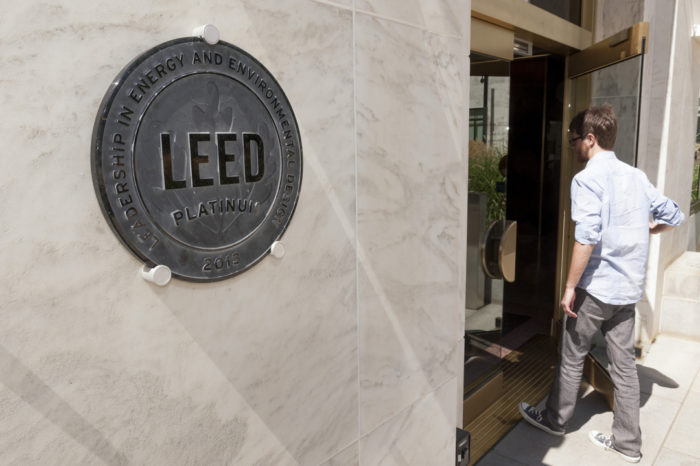
Image Credit: Oregon Department of Transportation /CC BY 2.0/ Flickr
The U.S. Green Building Council (USGBC) has announced that beginning on April 8, 2016, all new projects registering for LEED 2009 will need to satisfy increased minimum energy performance thresholds.
According to USGBC, the results of a recent ballot show that 78.6% percent of the consensus body voted in favor of this change to the 7-year-old rating system. By LEED rules, a minimum of two-thirds approval was needed for any balloted measure.
With this change, projects must now earn a minimum of four points in the Energy Performance credits. The referenced energy standard and modeling requirements in LEED 2009 will not change; buildings falling under the proposed change can use the same methodologies and referenced standards, but will need to earn additional points in order to achieve certification.
This change is significant. The requirement that LEED projects will need to satisfy increased energy performance requirements will no doubt increase first costs. This is a change to a longstanding rating system that is the benchmark in green building laws, construction contracts, and more.
Change applies for the short term
Recall that Rick Fedrizzi, retiring CEO of the USGBC, announced on October 29, 2014 that LEED users would be able to register projects under the LEED 2009 rating system until October 31, 2016. That extension was occasioned by the delay in LEED v4. Thus, this change will apply to LEED 2009 projects registering between April 8, 2016 and October 31, 2016 (the last day to register a project under LEED 2009).
Today, the Minimum Energy Performance prerequisite, using Option 1, Whole Building Energy Simulation, requires that the applicant:
Demonstrate a 10% improvement in the proposed building performance rating for new buildings, or a 5% improvement in the proposed building performance rating for major renovations to existing buildings, compared with the baseline building performance rating.
The changed credit language is:
For projects that register after 04/07/16 and are subject to the four point mandatory minimum, demonstrate an 18% improvement in the proposed building performance rating for new buildings, or a 14% improvement in the proposed building performance rating for major renovations to existing buildings, compared with the baseline building performance rating.
As indicated above, the referenced energy standard and modeling requirements do not change and still require the applicant to calculate the baseline building performance rating according to the building performance rating method in Appendix G of ANSI/ASHRAE/IESNA Standard 90.1-2007 (with errata but without addenda 25) using a computer simulation model for the whole building project. This is not a move to the newer 2010 version of the ASHRAE 90.1 standard.
You can read the specific changes in the USGBC’s Rating System document.
Note also that new point thresholds are provided for different building types (e.g., health care) to align the effective percentage increase in performance. Each of those is best identified in the Summary of changes.
The move may be destabilizing
It is difficult to argue against increasing energy efficiency, but this change to LEED 2009 may have a destabilizing effect, since it changes a rating system in midstream, with little advance notice, cutting against the certainty that the real estate industry craves (even in this instance when the effective window will only be for those projects registered through October 31, 2016).
Given that most building projects are budgeted, programmed, planned, and designed over a period of years, to propose a substantive change that will have significant first cost impact, to be effective in a matter of weeks, will reverberate throughout the building industry and no doubt expose participants to increased liability for this unexpected change. Additionally, projects attempting to comply with governmental mandates or contractual obligations for LEED certification may have problems complying.
You are urged to consider the impact this may have, in particular for projects not yet registered, with the thought that all projects pursuing LEED 2009 should now be registered by April 7, 2016, in advance of the effective date of the change.
Everyone involved with LEED projects should promptly review their contracts to determine the implications of this change in LEED and what amendments to contracts may be necessary.
Stuart Kaplow is an environmental attorney and a frequent contributor to GBA. This column was originally posted at Green Building Law Update. Kaplow is legal counsel and past chair of the U.S. Green Building Council Maryland.
Weekly Newsletter
Get building science and energy efficiency advice, plus special offers, in your inbox.















0 Comments
Log in or create an account to post a comment.
Sign up Log in